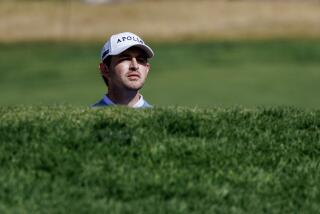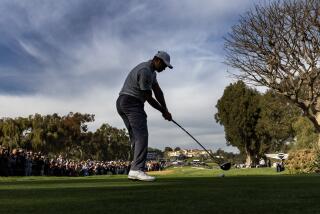This Rough Really Tough : Elkington, Calling It ‘Nasty Stuff,’ Says It Is So Severe ‘You Could Play the Open on It’
- Share via
Steve Elkington, a big, powerful slugger from Australia, won the PGA Championship on the Riviera Country Club course last summer, and after two rounds in the Nissan Open he thinks Hogan’s Alley is ready again for a U.S. Open.
“This is U.S. Open rough, no doubt about it,” he said after shooting a 70 for a 36-hole total of 137, a shot off Robert Wrenn’s lead. “This is the most severe rough we’ll see until the Open.
“It’s quite different from the way it was at the PGA. This week, if you’re in the rough around the green, you don’t think about trying to get it close. All you want to do is get it out.
“It’s pretty nasty stuff. You could play the Open on it and the USGA [United States Golf Assn.] wouldn’t have to make it any tougher.”
Riviera, the site of the U.S. Open in 1948, when Ben Hogan was so dominating that Riviera became known as Hogan’s Alley, isn’t on the USGA schedule for another main event, but it will play host to the 1998 U.S. Senior Open.
“Look at the scoreboard,” Elkington said. “It takes Open conditions to lead a tournament out here at only six under after two rounds. Riviera has toughened up. It wasn’t long ago the scores were much lower.”
Corey Pavin was 11 under par after two rounds in 1994 and Lanny Wadkins was 20 under when he won in 1985.
Wadkins, now 46, is three under par and, at 139, is only three shots behind Wrenn.
Elkington, who had three birdies and two bogeys, said the fourth hole, a 238-yard par-three, is one of the longest and toughest par-threes on the tour.
“I hit a three-wood and came up short,” he said. “I couldn’t chip it any closer than eight feet and missed my par putt. It’s a beautiful hole--it’s just long. I don’t think we play any hole longer all year, except maybe for one at Doral.”
Doral, in Miami, is where the tour heads next week, the Nissan Open concluding the West Coast portion of the PGA Tour.
Craig Stadler, who is tied with Elkington, hit his driver on No. 4--and also came up short. But he got up and down to save his par.
“It takes someone strong like Stadler to hit out of this rough,” Elkington said. “It’s not surprising he’s up at the top. The way he hits, he probably doesn’t even know the rough is there.”
Saving par at times is more rewarding than making birdies, or at least, equally so. Elkington had such an experience on No. 17, a 578-yard par-five.
His drive landed in the right rough, his second shot stayed on the same side, still in the rough, and then he hit across the fairway into the left rough. He slugged a wedge out of the thick, tangled grass and the ball stopped 20 feet from the cup. He made the putt, his longest of the round.
“That was a U.S. Open par right there,” he said.
By way of contrast, en route to his PGA victory, Elkington was four shots better, at 135, than he is today. And the cut for the PGA was even par 142, three shots fewer than the 145 it took to return for today’s 18 holes.
More to Read
Go beyond the scoreboard
Get the latest on L.A.'s teams in the daily Sports Report newsletter.
You may occasionally receive promotional content from the Los Angeles Times.










